人体器官英语词汇
- 格式:doc
- 大小:25.50 KB
- 文档页数:3

head 头throat 喉咙, 咽喉armpit hair 腋毛nipple 乳头chest 胸部pit 胸口navel 肚脐abdomen 腹部private parts 阴部thigh 大腿neck 脖子shoulder 肩back 背waist 腰hip 臀部buttock 屁股skull 颅骨, 头盖骨collarbone 锁骨rib 肋骨backbone 脊骨, 脊柱shoulder joint 肩关节shoulder blade 肩胛骨breastbone 胸骨elbow joint 肘关节pelvis 骨盆kneecap 膝盖骨bone 骨skeleton 骨骼sinew 腱muscle 肌肉joint 关节blood vessel 血管vein 静脉artery 动脉capillary 毛细血管nerve 神经spinal marrow 脊髓brain 脑respiration 呼吸windpipe 气管lung 肺heart 心脏diaphragm 隔膜internal organs 内脏gullet 食管stomach 胃liver 肝脏gall bladder 胆囊pancreas 胰腺spleen 脾duodenum 12指肠small intestine 小肠large intestine 大肠blind gut 盲肠vermiform appendix 阑尾rectum 直肠anus 肛门kidney 肾脏bladder 膀胱penis 阴茎testicles 睾丸scroticles 阴囊urine 尿道ovary 卵巢womb 子宫vagina 阴道hair 头发forehead 额temple 太阳穴eyebrow 眉毛eye 眼睛ear 耳朵cheek 面颊nose 鼻子lip 嘴唇mouth 口chin 下巴wrinkles 皱纹crow's-feet 鱼尾纹mole 痣Adam's apple 喉freckles 雀斑dimple 酒涡pimple 粉刺tooth 牙齿uvual 小舌tonsil 扁桃腺tongue 舌decayed tooth 龋齿gum 牙龈palate 上牙膛incisors 切齿, 门齿canine tooth 大齿premolars 前齿molars 后牙denlture 假齿mustache 小胡子beard 山羊胡whiskers 络腮胡sidebums 鬓角almond eye 杏仁眼double eye 双眼皮upturned nose 朝天鼻aquiline nose 鹰钩鼻snub nose 狮子鼻bulbous nose 球状鼻Grecian nose 悬胆鼻Roman nose 鹰鼻thumb 大拇指forefinger 食指middle finger 中指third finger 无名指little finger 小指palm 手掌ball 拇指腕掌nail 指甲half moon 甲晕fist 拳头knuckle 指关节back 手背wrist 手腕elbow 肘armpit 腋下thigh 大腿knee 膝盖shank 小腿calf 小腿肚foot 脚instep 脚背toes 脚趾ankle 踝Achilles's tendon 跟腱heel 脚后跟sole 脚底arch 脚掌心。
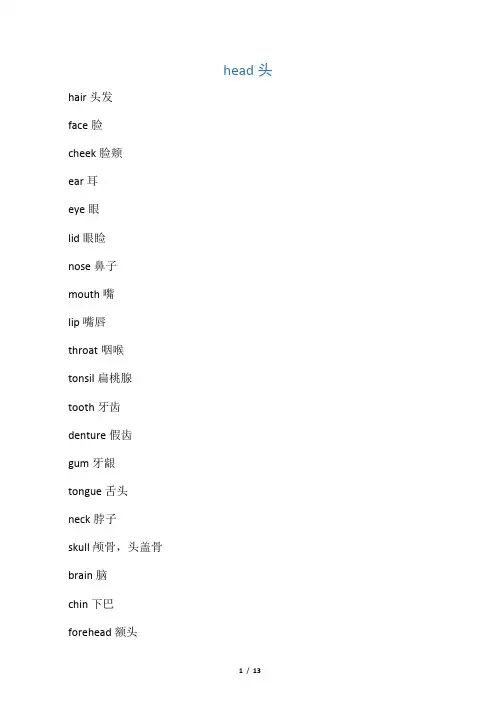
head头hair头发face脸cheek脸颊ear耳eye眼lid眼睑nose鼻子mouth嘴lip嘴唇throat咽喉tonsil扁桃腺tooth牙齿denture假齿gum牙龈tongue舌头neck脖子skull颅骨,头盖骨brain脑chin下巴forehead额头templexx mustachexx beardxx whisker络腮胡sidebums鬓角bald head秃头wrinkle皱纹mole胎块naevus痣freckle雀斑dimple酒涡pimple粉刺nipple乳头chest胸部navel肚脐abdomen腹部shoulder肩back背waist腰hip臀部buttock屁股collarbone锁骨rib肋骨backbone脊骨,脊柱breastbone胸骨joint关节pelvis骨盆sinew腱muscle肌肉bone骨skeleton骨骼blood vessel血管vein静脉artery动脉capillary毛细血管nerve神经spinal marrow脊髓kidney肾脏windpipe气管lung肺heart心脏diaphragm隔膜organ器官gullet食道stomach胃liver肝脏gall胆囊bladder膀胱pancreas胰腺spleen脾duodenum十二指肠small intestine小肠large intestine大肠appendix盲肠rectum直肠anus肛门urine尿道ovary卵巢wombxxvagina阴道thumb大拇指forefinger食指middle finger中指third finger无名指little finger小指palm手掌nail指甲fist拳头knuckle指关节the back of hand手背wrist手腕elbow肘armpit腋下thigh大腿kneecap膝盖骨thigh大腿knee膝盖shank小腿calf小腿肚foot脚instep脚背toe脚趾ankle踝heel脚后跟sole脚底arch脚掌心.An eye for eye, a tooth for tooth.以眼还眼,以牙还牙。
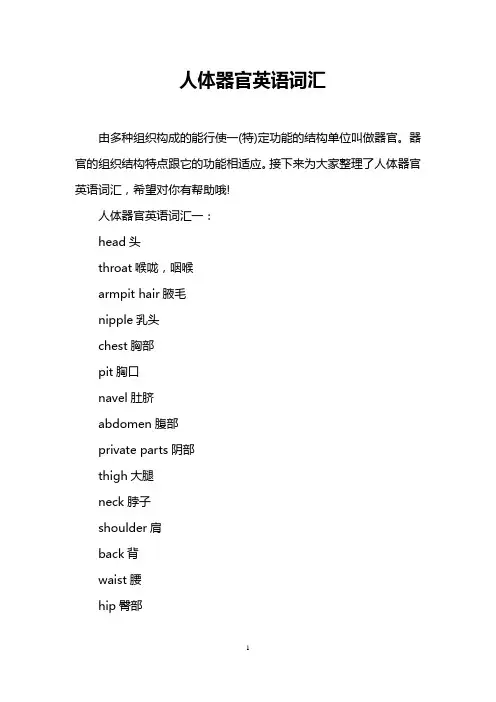
人体器官英语词汇由多种组织构成的能行使一(特)定功能的结构单位叫做器官。
器官的组织结构特点跟它的功能相适应。
接下来为大家整理了人体器官英语词汇,希望对你有帮助哦!人体器官英语词汇一:head头throat喉咙,咽喉armpit hair腋毛nipple乳头chest胸部pit胸口navel肚脐abdomen腹部private parts阴部thigh大腿neck脖子shoulder肩back背waist腰hip臀部buttock屁股skull颅骨,头盖骨collarbone锁骨rib肋骨backbone脊骨,脊柱shoulder joint肩关节shoulder blade肩胛骨breastbone胸骨elbow joint肘关节pelvis骨盆kneecap膝盖骨bone骨skeleton骨骼sinew腱muscle肌肉joint关节blood vessel血管vein静脉artery动脉capillary毛细血管nerve神经spinal marrow脊髓brain脑人体器官英语词汇二:respiration呼吸windpipe气管lung肺heart心脏diaphragm隔膜exhale呼出inhale呼入internal organs内脏gullet食管stomach胃liver肝脏large intestine大肠blind gut盲肠vermiform appendix阑尾rectum直肠anus肛门bite咬chew咀嚼knead揉捏swallow咽下digest消化absord吸收discharge排泄excrement粪便kidney肾脏bladder膀胱penis阴茎testicles睾丸scroticles阴囊gall bladder胆囊pancreas胰腺spleen脾duodenum12指肠small intestine小肠。
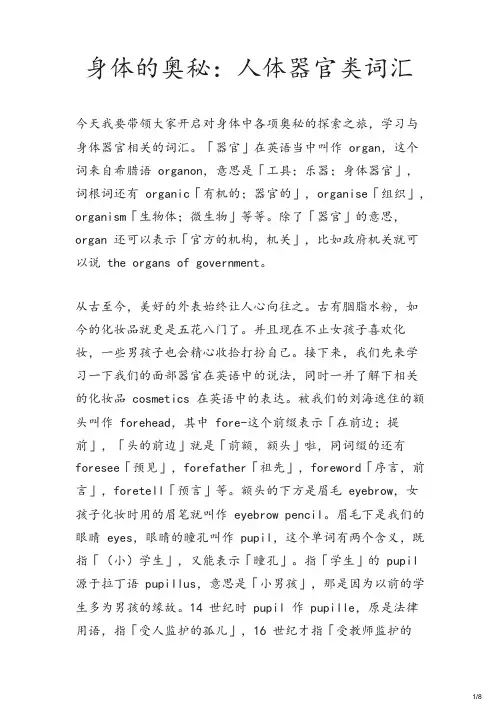
身体的奥秘:人体器官类词汇今天我要带领大家开启对身体中各项奥秘的探索之旅,学习与身体器官相关的词汇。
「器官」在英语当中叫作 organ,这个词来自希腊语 organon,意思是「工具;乐器;身体器官」,词根词还有 organic「有机的;器官的」,organise「组织」,organism「生物体;微生物」等等。
除了「器官」的意思,organ 还可以表示「官方的机构,机关」,比如政府机关就可以说 the organs of government。
从古至今,美好的外表始终让人心向往之。
古有胭脂水粉,如今的化妆品就更是五花八门了。
并且现在不止女孩子喜欢化妆,一些男孩子也会精心收拾打扮自己。
接下来,我们先来学习一下我们的面部器官在英语中的说法,同时一并了解下相关的化妆品 cosmetics 在英语中的表达。
被我们的刘海遮住的额头叫作 forehead,其中 fore-这个前缀表示「在前边;提前」,「头的前边」就是「前额,额头」啦,同词缀的还有foresee「预见」,forefather「祖先」,foreword「序言,前言」,foretell「预言」等。
额头的下方是眉毛 eyebrow,女孩子化妆时用的眉笔就叫作 eyebrow pencil。
眉毛下是我们的眼睛 eyes,眼睛的瞳孔叫作 pupil,这个单词有两个含义,既指「(小)学生」,又能表示「瞳孔」。
指「学生」的 pupil 源于拉丁语 pupillus,意思是「小男孩」,那是因为以前的学生多为男孩的缘故。
14 世纪时 pupil 作 pupille,原是法律用语,指「受人监护的孤儿」,16 世纪才指「受教师监护的人」,也就是「(小)学生」。
指「瞳孔」的 pupil 则源于拉丁语 pupilla,意思是「小女孩,小洋娃娃」,那是因为瞳孔所反映的人像酷似小洋娃娃所以得名的,14 世纪时也作pupille,同样指「受监护的孤儿」。
两个 pupil 虽然词源不尽相同,但却都是经由同一法语形式 pupille 进入英语的。
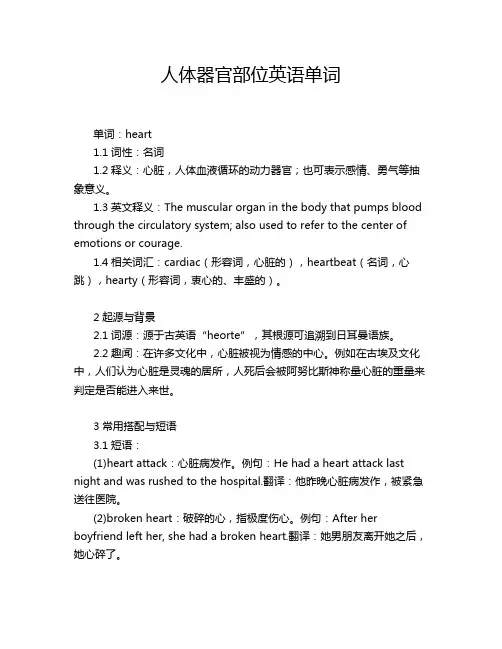
人体器官部位英语单词单词:heart1.1词性:名词1.2释义:心脏,人体血液循环的动力器官;也可表示感情、勇气等抽象意义。
1.3英文释义:The muscular organ in the body that pumps blood through the circulatory system; also used to refer to the center of emotions or courage.1.4相关词汇:cardiac(形容词,心脏的),heartbeat(名词,心跳),hearty(形容词,衷心的、丰盛的)。
2起源与背景2.1词源:源于古英语“heorte”,其根源可追溯到日耳曼语族。
2.2趣闻:在许多文化中,心脏被视为情感的中心。
例如在古埃及文化中,人们认为心脏是灵魂的居所,人死后会被阿努比斯神称量心脏的重量来判定是否能进入来世。
3常用搭配与短语3.1短语:(1)heart attack:心脏病发作。
例句:He had a heart attack last night and was rushed to the hospital.翻译:他昨晚心脏病发作,被紧急送往医院。
(2)broken heart:破碎的心,指极度伤心。
例句:After her boyfriend left her, she had a broken heart.翻译:她男朋友离开她之后,她心碎了。
(3)heart disease:心脏疾病。
例句:Smoking is a major cause of heart disease.翻译:吸烟是心脏疾病的一个主要原因。
(4)by heart:牢记。
例句:I learned all the lines of the poem by heart.翻译:我把这首诗的所有诗句都背下来了。
4实用片段(1) "I can feel my heart beating so fast. I must be really nervous about this job interview." She said to her friend.翻译:“我能感觉到我的心跳得好快。

英语身体部位词汇xx年xx月xx日contents •头部和颈部词汇•躯干和背部词汇•四肢和手部词汇•身体部位的应用目录01头部和颈部词汇头部指头部的前部和侧面,包括脸颊、额头、鼻子、嘴巴和下巴。
faceforeheadtemplecheek指头部的上部,即发际线以上的部分。
指头两侧的区域,包括太阳穴和附近的骨头。
指脸颊,即眼睛下方的面颊骨和软组织。
颈部指连接头部和躯干之间的部分,包括颈部的前部、后部和两侧。
neck指颈部的底部,通常与吞咽和呼吸有关。
throat指下颌骨的前端,通常与面部轮廓有关。
chin 指颈部的后部,通常与头发有关。
nape02躯干和背部词汇指人体除头部、四肢外的中央部分,包括胸部、腹部和背部。
torso指人体上半部分,包括胸骨、肋骨和心脏。
chest指人体腹部,通常指肚脐以下的区域。
abdomen指人体背部,从后脑勺到腰部。
back躯干背部指构成脊柱的每一块骨头。
vertebra指由多个椎骨组成的支撑和保护人体脊髓的柱状物。
spinal column指支持人体姿势和运动的脊柱。
backbone 指由多个椎骨组成的支撑和保护人体脊髓的柱状物,也称为spine或backbone。
vertebral column03四肢和手部词汇包括上臂、前臂和手腕,常用于描述人的手臂长度、位置、运动等。
Arm包括肩胛骨和锁骨,常用于描述肩膀的宽窄、高低、活动能力等。
Shoulder肘部,常用于描述手臂弯曲处的位置和运动。
Elbow手腕,常用于描述前臂和手之间的关节处。
Wrist上肢下肢包括大腿、小腿和脚踝,常用于描述人的腿的长度、位置、运动等。
Leg Hip KneeAnkle 臀部,常用于描述大腿骨和盆骨连接的位置。
膝盖,常用于描述大腿和小腿之间的关节处。
脚踝,常用于描述小腿和脚之间的关节处。
04身体部位的应用1描述位置关系23描述位置时,可以使用“head up”或“head towards”表达垂直或方向关系。
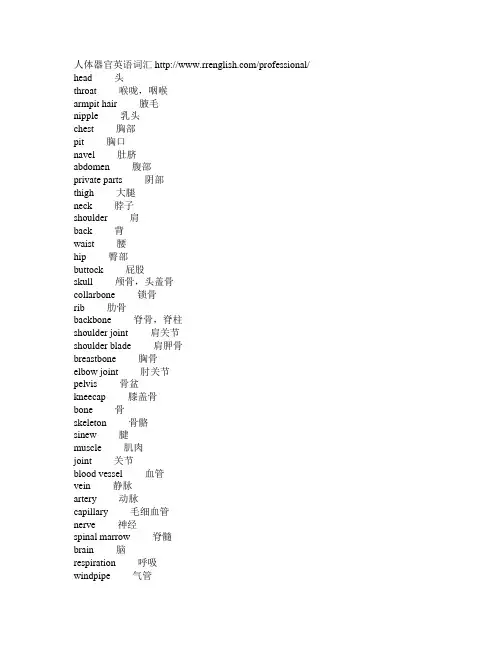
人体器官英语词汇/professional/ head头throat 喉咙,咽喉armpit hair腋毛nipple乳头chest 胸部pit 胸口navel 肚脐abdomen腹部private parts阴部thigh 大腿neck 脖子shoulder 肩back背waist 腰hip 臀部buttock 屁股skull 颅骨,头盖骨collarbone 锁骨rib 肋骨backbone 脊骨,脊柱shoulder joint 肩关节shoulder blade 肩胛骨breastbone胸骨elbow joint 肘关节pelvis 骨盆kneecap膝盖骨bone 骨skeleton 骨骼sinew 腱muscle 肌肉joint 关节blood vessel血管vein 静脉artery 动脉capillary 毛细血管nerve神经spinal marrow脊髓brain 脑respiration 呼吸windpipe 气管lung 肺heart 心脏diaphragm 隔膜exhale 呼出inhale 呼入internal organs 内脏gullet 食管stomach 胃liver 肝脏gall bladder 胆囊pancreas 胰腺spleen 脾duodenum 12指肠small intestine 小肠large intestine 大肠blind gut盲肠vermiform appendix阑尾rectum 直肠anus 肛门bite 咬chew 咀嚼knead 揉捏swallow 咽下digest 消化absord 吸收discharge排泄excrement粪便kidney 肾脏bladder膀胱penis 阴茎testicles睾丸scroticles 阴囊urine 尿道ovary 卵巢womb 子宫vagina阴道超市食品名称(中英对照) A. 肉品类 (鸡, 猪, 牛)Fresh Grade Legs 大鸡腿Fresh Grade Breast 鸡胸肉Chicken Drumsticks 小鸡腿Chicken Wings 鸡翅膀Minced Steak 绞肉Pigs Liver 猪肝Pigs feet 猪脚Pigs Kidney 猪腰Pigs Hearts 猪心Pork Steak 没骨头的猪排Pork Chops 连骨头的猪排Rolled Porkloin 卷好的腰部瘦肉Rolled Pork Belly 卷好的腰部瘦肉连带皮Pork sausage meat 做香肠的绞肉Smoked Bacon 醺肉Pork Fillet 小里肌肉Spare Rib Pork chops 带骨的瘦肉Spare Rib of Pork 小排骨肉Pork ribs 肋骨可煮汤食用Black Pudding 黑香肠Pork Burgers 汉堡肉Pork-pieces 一块块的廋肉Pork Dripping 猪油滴Lard 猪油Hock 蹄膀Casserole Pork 中间带骨的腿肉Joint 有骨的大块肉Stewing Beef 小块的瘦肉Steak & Kidney 牛肉块加牛腰Frying steak 可煎食的大片牛排Mimced Beef 牛绞肉Rump Steak 大块牛排Leg Beef 牛键肉OX-Tail 牛尾OX-heart 牛心OX-Tongues 牛舌Barnsley Chops 带骨的腿肉Shoulder Chops 肩肉Porter House Steak 腰上的牛排肉Chuck Steak 头肩肉筋、油较多Tenderised Steak 拍打过的牛排Roll 牛肠Cowhells 牛筋Pig bag 猪肚Homeycome Tripe 蜂窝牛肚Tripe Pieces 牛肚块Best thick seam 白牛肚B. 海产类Herring 鲱Salmon 鲑Cod 鳕Tuna 鲔鱼Plaice 比目鱼Octopus 章鱼Squid 乌贼Dressed squid 花枝Mackerel 鲭Haddock 北大西洋产的鳕鱼Trout 鳟鱼、适合蒸来吃Carp 鲤鱼Cod Fillets 鳕鱼块,可做鱼羹,或炸酥鱼片都很好吃Conger (Eel) 海鳗Sea Bream 海鲤Hake 鳕鱼类Red Mullet 红鲣,可煎或红烧来吃Smoked Salmon 熏鲑*Smoked mackerel with crushed pepper corn 带有黑胡椒粒的熏鲭* Herring roes 鲱鱼子Boiled Cod roes 鳕鱼子Oyster 牡蛎Mussel 蚌、黑色、椭圆形、没壳的即为淡菜Crab 螃蟹Prawn 虾Crab stick 蟹肉条Peeled Prawns 虾仁King Prawns 大虾Winkles 田螺Whelks Tops 小螺肉Shrimps 小虾米Labster 龙虾C. 蔬果类Potato 马铃薯Carrot 红萝卜Onion 洋葱Aubergine 茄子Celery 芹菜White Cabbage 包心菜Red cabbage 紫色包心菜Cucumber 大黄瓜Tomato 蕃茄Radish 小红萝卜Mooli 白萝卜Watercress 西洋菜Baby corn 玉米尖Sweet corn 玉米Cauliflower 白花菜Spring onions 葱Garlic 大蒜Ginger 姜Chinese leaves 大白菜Leeks 大葱Mustard & cress 芥菜苗Green Pepper 青椒Red pepper 红椒Yellow pepper 黄椒Mushroom 洋菇Broccoliflorets 绿花菜Courgettes 绿皮南瓜,形状似小黄瓜,但不可生食Coriander 香菜Dwarf Bean 四季豆Flat Beans 长形平豆Iceberg 透明包心菜Lettuce 莴苣菜Swede or Turnip 芜菁Okra 秋葵Chillies 辣椒Taro 大芋头Sweet potato 蕃薯Spinach 菠菜Beansprots 绿豆芽Peas 碗豆Corn 玉米粒Sprot 高丽小菜心Lemon 柠檬Pear 梨子Banana 香蕉Grape 葡萄Golden apple 黄绿苹果、脆甜Granny smith 绿苹果、较酸Bramleys 可煮食的苹果Peach 桃子Orange 橙Strawberry 草莓Mango 芒果Pine apple 菠萝Kiwi 奇异果Starfruit 杨桃Honeydew-melon 蜜瓜Cherry 樱桃Date 枣子lychee 荔枝Grape fruit 葡萄柚Coconut 椰子Fig 无花果D. 其它Long rice 长米,较硬,煮前先泡一个小时Pudding rice or short rice 短米,较软Brown rice 糙米THAI Fragrant rice 泰国香米* Glutinous rice 糯米*Strong flour 高筋面粉Plain flour 中筋面粉Self- raising flour 低筋面粉Whole meal flour 小麦面粉Brown sugar 砂糖(泡奶茶、咖啡适用)dark Brown Sugar 红糖(感冒时可煮姜汤时用)Custer sugar 白砂糖(适用于做糕点)Icing Sugar 糖粉Rock Sugar 冰糖Noodles 面条Instant noodles 方便面Soy sauce 酱油,分生抽浅色及老抽深色两种Vinger 醋Cornstarch 太白粉Maltose 麦芽糖Sesame Seeds 芝麻Sesame oil 麻油Oyster sauce 蚝油Pepper 胡椒Red chilli powder 辣椒粉Sesame paste 芝麻酱Beancurd sheet 腐皮Tofu 豆腐Sago 西贾米Creamed Coconut 椰油Monosidum glutanate 味精Chinese red pepper 花椒Salt black bean 豆鼓Dried fish 鱼干Sea vegetable or Sea weed 海带Green bean 绿豆Red Bean 红豆Black bean 黑豆Red kidney bean 大红豆Dried black mushroom 冬菇Pickled mustard-green 酸菜Silk noodles 粉丝Agar-agar 燕菜Rice-noodle 米粉Bamboo shoots 竹笋罐头Star anise 八角Wantun skin 馄饨皮Dried chestuts 干粟子Tiger lily buds 金针Red date 红枣Water chestnuts 荸荠罐头Mu-er 木耳Dried shrimps 虾米Cashewnuts 腰果酒店常用各种英语词汇服务台常用词汇management 经营、管理market price 市价cashier's desk 兑换处coin 硬币accounting desk 帐务处check_out time 退房时间voucher 证件price list 价目表check, cheque 支票sign (动)签字interest 利息form 表格reservation 预订reception desk 接待处tip 小费reservation desk 预订处luggage office 行李房…per thousand 千分之…spare (形)多余的postpone (动)延期cancel (动)取消traveller's cheque 旅行支票pay (动)付款fill (动)填写administration 管理、经营note 纸币registration desk 入宿登记处lobby 前厅luggage rack 行李架visit card 名片identification card 身份证rate of exchange 兑换率conversion rate 换算率charge (动)收费bill 帐单change money 换钱procedure 手续、程序information desk 问询处luggage label 行李标签overbooking 超额订房…per cent 百分之…reasonable (形)合理的cash (动)兑换keep (动)保留、保存bank draft 汇票accept (动)接受procedure fee 手续费fill in the form 填表■ 电讯服务operator 电话员house phone 内部电话special line 专线dial a number 拨号码hold the line 别挂电话can't put somebody through 接不通ordinary telegram 普通电话receiver 听筒city phone 城市电话telephone number 电话号码replace the phone 挂上电话Line, please. 请接外线。
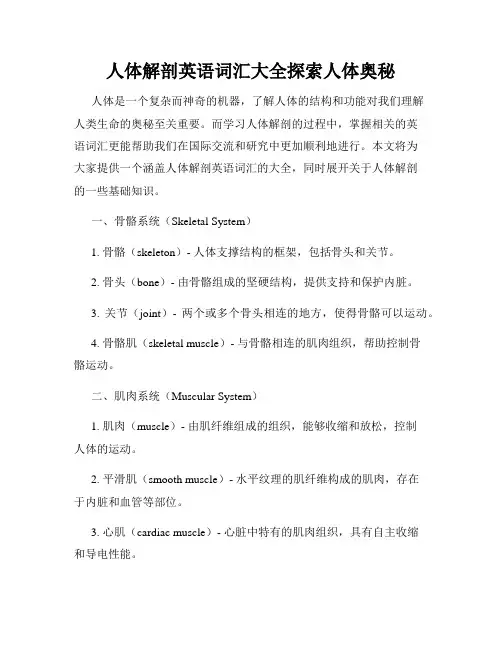
人体解剖英语词汇大全探索人体奥秘人体是一个复杂而神奇的机器,了解人体的结构和功能对我们理解人类生命的奥秘至关重要。
而学习人体解剖的过程中,掌握相关的英语词汇更能帮助我们在国际交流和研究中更加顺利地进行。
本文将为大家提供一个涵盖人体解剖英语词汇的大全,同时展开关于人体解剖的一些基础知识。
一、骨骼系统(Skeletal System)1. 骨骼(skeleton)- 人体支撑结构的框架,包括骨头和关节。
2. 骨头(bone)- 由骨骼组成的坚硬结构,提供支持和保护内脏。
3. 关节(joint)- 两个或多个骨头相连的地方,使得骨骼可以运动。
4. 骨骼肌(skeletal muscle)- 与骨骼相连的肌肉组织,帮助控制骨骼运动。
二、肌肉系统(Muscular System)1. 肌肉(muscle)- 由肌纤维组成的组织,能够收缩和放松,控制人体的运动。
2. 平滑肌(smooth muscle)- 水平纹理的肌纤维构成的肌肉,存在于内脏和血管等部位。
3. 心肌(cardiac muscle)- 心脏中特有的肌肉组织,具有自主收缩和导电性能。
4. 横纹肌(striated muscle)- 具有横纹纹理的肌肉,包括骨骼肌和心肌。
三、呼吸系统(Respiratory System)1. 呼吸(respiration)- 人体吸入氧气,排出二氧化碳的过程。
2. 气管(trachea)- 连接喉部和支气管的管道。
3. 支气管(bronchus)- 气管分支而成,将空气输送到肺部。
4. 肺(lung)- 呼吸系统的关键器官,用来进行气体交换。
四、循环系统(Circulatory System)1. 心脏(heart)- 位于胸腔中的肌肉器官,泵血循环。
2. 动脉(artery)- 将氧气和营养物质输送到全身组织的血管。
3. 静脉(vein)- 将含有二氧化碳和废物的血液输送回心脏的血管。
4. 血液(blood)- 循环系统中的液体,携带氧气和营养物质。
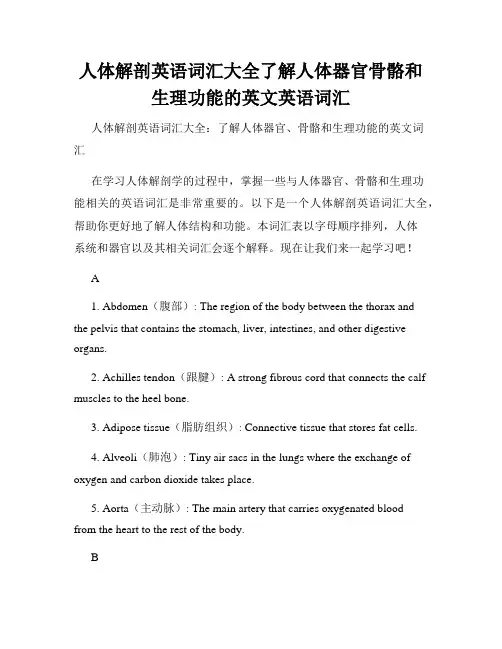
人体解剖英语词汇大全了解人体器官骨骼和生理功能的英文英语词汇人体解剖英语词汇大全:了解人体器官、骨骼和生理功能的英文词汇在学习人体解剖学的过程中,掌握一些与人体器官、骨骼和生理功能相关的英语词汇是非常重要的。
以下是一个人体解剖英语词汇大全,帮助你更好地了解人体结构和功能。
本词汇表以字母顺序排列,人体系统和器官以及其相关词汇会逐个解释。
现在让我们来一起学习吧!A1. Abdomen(腹部): The region of the body between the thorax andthe pelvis that contains the stomach, liver, intestines, and other digestive organs.2. Achilles tendon(跟腱): A strong fibrous cord that connects the calf muscles to the heel bone.3. Adipose tissue(脂肪组织): Connective tissue that stores fat cells.4. Alveoli(肺泡): Tiny air sacs in the lungs where the exchange of oxygen and carbon dioxide takes place.5. Aorta(主动脉): The main artery that carries oxygenated bloodfrom the heart to the rest of the body.B1. Bladder(膀胱): A muscular sac that stores urine produced by the kidneys.2. Bile(胆汁): A bitter, greenish-yellow fluid produced by the liver that helps in the digestion and absorption of fats.3. Brain(大脑): The control center of the nervous system, responsible for processing and coordinating sensory information and motor responses.4. Bronchi(支气管): The two main branches of the trachea that lead to the lungs.5. Bones(骨骼): Rigid organs composed of calcium, phosphorus, and collagen fibers that provide support, protection, and movement.C1. Cartilage(软骨): Flexible connective tissue found in the joints, nose, and ears that provides support and reduces friction between bones.2. Circulatory system(循环系统): The system responsible for the transport of blood, oxygen, nutrients, hormones, and wastes throughout the body.3. Colon(结肠): The longest portion of the large intestine, responsible for absorbing water and electrolytes from undigested food.4. Cranial nerves(脑神经): The 12 pairs of nerves that arise directly from the brain and are responsible for sensory and motor functions of the head and neck.5. Capillaries(毛细血管): Tiny blood vessels that connect arterioles to venules and facilitate the exchange of nutrients and waste products between cells and blood.D1. Diaphragm(膈肌): A dome-shaped muscle below the lungs that separates the thoracic and abdominal cavities and plays a crucial role in breathing.2. Digestive system(消化系统): The system responsible for the breakdown and absorption of food, including the mouth, esophagus, stomach, intestines, liver, and pancreas.3. Dorsal cavity(背腔): The posterior cavity of the body that contains the cranial and vertebral cavities.4. Dendrite(树突): Branch-like extensions of a nerve cell that receive incoming signals and transmit them to the cell body.5. Dermis(真皮): The middle layer of the skin that contains blood vessels, hair follicles, sweat glands, and nerve endings.E1. Esophagus(食道): A muscular tube that connects the throat to the stomach and transports food from the mouth to the stomach.2. Endocrine system(内分泌系统): The system responsible for producing and releasing hormones to regulate various bodily functions, including growth, metabolism, and reproduction.3. Epidermis(表皮): The outermost layer of the skin that provides protection against pathogens, water loss, and UV radiation.4. Epithelial tissue(上皮组织): Tissue that covers the external and internal surfaces of the body, including the skin and mucous membranes.5. Excretory system(排泄系统): The system responsible for eliminating metabolic waste products from the body, including the kidneys, ureters, bladder, and urethra.F1. Femur(股骨): The longest and strongest bone in the body, located in the thigh region.2. Frontal lobe(额叶): The anterior part of the cerebral cortex responsible for higher cognitive functions, including decision-making, problem-solving, and emotion regulation.3. Flexor(屈肌): A muscle that bends or flexes a joint.4. Fallopian tubes(输卵管): Tubes that extend from the ovaries to the uterus and serve as the site for fertilization of the egg by sperm.G1. Gallbladder(胆囊): A pear-shaped organ that stores and concentrates bile produced by the liver.2. Glomerulus(肾小球): A network of tiny blood vessels in the kidney where blood filtration occurs.3. Gonads(性腺): The reproductive organs that produce gametes –ovaries in females and testes in males.4. Glands(腺体): Organs that secrete hormones or other substances, such as sweat glands and salivary glands.H1. Heart(心脏): A muscular organ that pumps oxygenated blood to the body and deoxygenated blood to the lungs.2. Hypothalamus(下丘脑): A small region of the brain that acts as a control center for regulating body temperature, hunger, thirst, and hormone production.3. Humerus(肱骨): The bone in the upper arm, between the shoulder and the elbow.4. Homeostasis(动态平衡): The ability of the body to maintain a stable internal environment despite external changes.I1. Integumentary system(皮肤系统): The system composed of the skin, hair, nails, and associated glands, responsible for protection, temperature regulation, and sensory reception.2. Incisor(切牙): The sharp-edged front teeth used for cutting and biting food.3. Inferior vena cava(下腔静脉): The largest vein in the body that returns deoxygenated blood from the lower body to the heart.4. Iris(虹膜): The colored part of the eye that controls the size of the pupil and regulates the amount of light entering the eye.J1. Joint(关节): The point of connection or articulation between two or more bones, allowing for movement and flexibility.2. Jejunum(空肠): The middle portion of the small intestine responsible for further digestion and absorption of nutrients.K1. Kidneys(肾脏): The paired organs responsible for filtering waste products, excess nutrients, and water from the blood to form urine.2. Keratin(角蛋白): A tough protein found in the epidermis, hair, and nails that provides strength and protection.L1. Lungs(肺): The paired respiratory organs responsible for gas exchange, supplying oxygen to the blood and removing carbon dioxide.2. Liver(肝脏): The largest gland in the body that produces bile, detoxifies harmful substances, stores nutrients, and performs other vital metabolic functions.3. Lymphatic system(淋巴系统): The network of vessels, lymph nodes, and organs responsible for defending the body against pathogens and maintaining fluid balance.4. Ligaments(韧带): Strong bands of connective tissue that connect bones and provide stability to joints.M1. Muscles(肌肉): Contractile tissues responsible for movement, support, and heat production in the body.2. Medulla oblongata(延髓): The lower part of the brainstem responsible for controlling vital functions, such as breathing, heart rate, and blood pressure.3. Molars(磨牙): The back teeth used for grinding and chewing food.4. Metabolism(新陈代谢): The sum of all chemical reactions that occur in the body to maintain life and energy balance.N1. Nervous system(神经系统): The complex network of nerves and cells that transmit signals between different parts of the body, enabling communication and coordination.2. Nephron(肾单位): The functional unit of the kidney responsible for filtering blood and producing urine.3. Neurons(神经元): Nerve cells that transmit electrical signals throughout the body.4. Nasal cavity(鼻腔): The hollow space inside the nose that filters, warms, and moistens inhaled air.O1. Ovaries(卵巢): The female reproductive organs that produce eggs and release hormones, such as estrogen and progesterone.2. Osteoporosis(骨质疏松): A condition characterized by weak and brittle bones, often associated with aging or hormonal changes.3. Optic nerve(视神经): The nerve that carries visual information from the retina to the brain.P1. Pancreas(胰腺): An organ that produces insulin and other digestive enzymes to regulate blood sugar levels and aid in digestion.2. Pituitary gland(垂体): The master gland of the endocrine system that controls the release of hormones from other glands and regulates growth and development.3. Pharynx(咽部): The muscular tube at the back of the throat that serves as a passageway for food and air.4. Patella(髌骨): The kneecap, a small bone located in front of the knee joint.5. Pupil(瞳孔): The opening in the center of the iris that controls the amount of light entering the eye.Q1. Quadriceps(四头肌): A group of four muscles at the front of the thigh that help extend the leg and stabilize the knee joint.2. Quiescent(静止的): Inactive or dormant, often used to describe cells or tissues with reduced metabolic activity.R1. Retina(视网膜): The light-sensitive layer at the back of the eye that contains photoreceptor cells responsible for detecting and processing visual stimuli.2. Radius(桡骨): One of the two bones in the forearm, located on the thumb side.3. Rib(肋骨): Curved bones that form the rib cage, protecting the organs in the thoracic cavity.4. Renal artery(肾动脉): The blood vessel that supplies oxygenated blood to the kidneys.S1. Spinal cord(脊髓): The long, thin bundle of nerves that extends from the brainstem to the lower back, transmitting sensory and motor signals between the brain and the rest of the body.2. Stomach(胃): A muscular organ that receives and breaks down food through mechanical and chemical digestion.3. Small intestine(小肠): The part of the digestive tract where most of the nutrient absorption takes place.4. Spleen(脾脏): An organ located behind the stomach that filters the blood, stores red blood cells, and helps in the immune response.5. Sweat glands(汗腺): Glands in the skin that produce sweat to regulate body temperature.T1. Trachea(气管): The windpipe, a tube that carries air from the throat to the bronchi.2. Thyroid gland(甲状腺): A gland in the neck that produces hormones important for metabolism, growth, and development.3. Testes(睾丸): Male reproductive organs that produce sperm and release testosterone.4. Tendon(肌腱): A flexible band of fibrous tissue that connects muscle to bone.5. Temporal lobe(颞叶): The lobe of the cerebral cortex responsible for auditory processing and memory.U1. Urethra(尿道): The tube that carries urine from the bladder to the outside of the body.2. Uterus(子宫): A hollow, muscular organ in females where the fetus develops during pregnancy.V1. Vein(静脉): Blood vessels that carry deoxygenated blood back to the heart.2. Ventricle(心室): One of the two lower chambers of the heart that pumps blood out of the heart and into the circulatory system.W1. White blood cells(白细胞): Cells of the immune system that defend the body against pathogens and foreign substances.2. Wrist(腕关节): The joint that connects the hand to the forearm.X1. Xiphoid process(剑突): The small, cartilaginous extension at the lower end of the sternum.Y1. Yolk sac(卵黄囊): A membranous sac that provides nourishment to the developing embryo in the early stages of pregnancy.Z1. Zygote(受精卵): The cell formed by the union of an egg and sperm during fertilization.希望这个人体解剖英语词汇大全对你有所帮助!通过学习与人体结构和功能相关的英语词汇,你将更好地理解人体解剖学的知识。
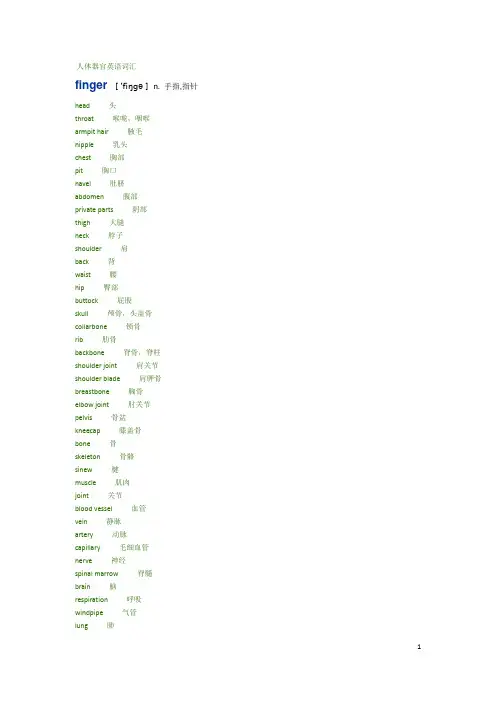
人体器官英语词汇finger[ 'fiŋgə ] n. 手指,指针head头throat 喉咙,咽喉armpit hair腋毛nipple乳头chest 胸部pit 胸口navel 肚脐abdomen腹部private parts阴部thigh 大腿neck 脖子shoulder 肩back背waist 腰hip 臀部buttock 屁股skull 颅骨,头盖骨collarbone 锁骨rib 肋骨backbone 脊骨,脊柱shoulder joint 肩关节shoulder blade 肩胛骨breastbone胸骨elbow joint 肘关节pelvis 骨盆kneecap膝盖骨bone 骨skeleton 骨骼sinew 腱muscle 肌肉joint 关节blood vessel血管vein 静脉artery 动脉capillary 毛细血管nerve神经spinal marrow脊髓brain 脑respiration 呼吸windpipe 气管lung 肺heart 心脏diaphragm 隔膜exhale 呼出inhale 呼入internal organs 内脏gullet 食管stomach 胃liver 肝脏gall bladder 胆囊pancreas 胰腺spleen 脾duodenum 12指肠small intestine 小肠large intestine 大肠blind gut盲肠vermiform appendix阑尾rectum 直肠anus 肛门bite 咬chew 咀嚼knead 揉捏swallow 咽下digest 消化absord 吸收discharge排泄excrement粪便kidney 肾脏bladder膀胱penis 阴茎testicles睾丸scroticles 阴囊urine 尿道ovary 卵巢womb 子宫vagina阴道orensic medicine 法医学doctor, physician 医生,医师,内科医师family doctor 家庭医生pediatrician, pediatrist 儿科医师gynecologist 妇科医师tocologist, obstetrician 产科医师neurologist 神经专家psychiatrist 精神病学专家ophthalmologist, oculist 眼科专家dentist, odontologist 牙医师surgeon 外科医师anesthetist, anaesthetist 麻醉师nurse 护士hospital医院clinic 诊所sanatorium 疗养院health 健康healthy (个人)健康wholesome 合乎卫生的,有益于健康的hygiene 卫生to get vaccinated 接种sick person, patient 病员,患者to be sick, to be ill患病sickly 多病ailment, complaint 疾病pain 疼,痛indisposition, slight illness 不适unwell, indisposed 不适的affection, disease 疾病ulcer 溃疡wound 创伤,伤口lesion 损害injury 损伤rash, eruption疹spot 点,斑pimple 丘疹,小疮blackhead 黑头粉刺blister 水疱scab, boil痂scar 癜痕wart 疣,肉赘callus, callosity 胼胝corn 鸡眼chilblain冻疮bruise 挫伤ecchymosis 瘀癍bump 肿swelling 肿胀contusion 挫伤sprain, twist扭伤fracture 骨折symptom 症状diagnosis 诊断case 病例incubation 潜伏epidemic 流行病contagion 传染fever 热attack, access, fit发作coughing fit咳嗽发作to take to one’s bed 卧床to sneeze 打喷嚏faint, fainting fit 晕厥vertigo, dizziness 眩晕to feel sick 恶心to lose consciousness 失去知觉concussion 震荡coma 昏迷diet 饮食treatment 疗法to get better, to improve 好转cure 治愈relapse 复发常用医学词根医学专业英语词汇往往都比较长,这心然会给广大医务工作者记忆单词带来极大的困难。
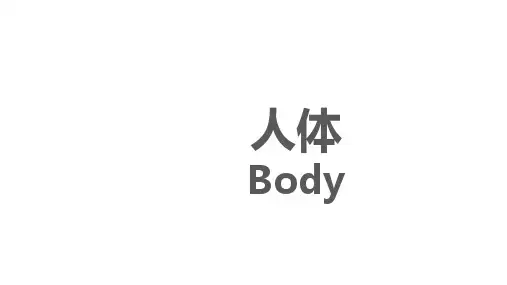
戈洛博翻译- 英语词汇库英语专题分类词汇(人体部位Human Body Parts)human organ 器官;head 头;scalp 头皮;dandruff 头皮屑;hair follicle 毛囊;crown 头顶;bald head 秃头/光头;hair 头发;forelock留海/额发;blond hair 金发;kinky hair 卷缩发;wavy hair 波浪发;straight hair 直发;forehead 额/脑门;temple太阳穴;philtrum 人中;ophryon 印堂;sidebums 鬓角;face 脸;wrinkle 皱纹;crow's feet 鱼尾纹;freckle 雀斑;dimple 酒涡;pimple 粉刺;wart 瘊子;naevus/mole 痦子;pockmark 麻子;naevus/mole 痣;cheekbone 颧骨;chin 下巴;cheek 面颊;jaw 颚;maxilla 上颚;mandible 下颚;jawbone 颚骨;eye 眼睛;right eye 左眼;left eye 右眼;dark eye 黑眼睛;brown eye 茶色眼睛;blue eye 蓝眼睛;hazel eye 淡褐色眼睛;almond eye 杏仁眼;phoenix eye 丹凤眼;cross eyes 对眼/斗鸡眼;double eyelid 双眼皮;single-fold eyelid 单眼皮;eyebrow/brows 眉毛;eyelash 睫毛;eyelid 眼皮/眼睑;eyeball 眼珠;white of the eye 眼白;cornea 角膜;conjunctiva结膜;iris 虹膜;sclera 巩膜;pupil 瞳孔;choroid脉络膜;retina 视网膜;optic disc 视神经盘;macula lutea 视网膜黄斑;aqueous humor(眼球的)水状体;lens(眼球的)晶状体;vitreous body(眼球的)玻璃体;ciliary body(眼球的)睫状体;lacrimal apparatus 泪器;ophthalmic 眼动脉;ear耳朵;right ear 左耳;left ear 右耳;inner ear canal内耳道;lobe 耳垂;earwax 耳垢;eardrum 耳膜;left eustachian tube 左耳咽管;right eustachan tube 右耳咽管;auditory canal 听道;aural nerve 听觉神经;tympanic cavity 鼓室;auditory tube 咽鼓管;vestibule 前庭;cochlea 耳蜗;semicircular canal 半规管;nose 鼻子;nasal cavity 鼻腔;nasal passages 鼻道;nostril 鼻孔; vibrissa/rhinothrix 鼻毛;snot 鼻涕;bridge of the nose 鼻梁;upturned nose 朝天鼻;aquiline nose 鹰钩鼻;snub nose 狮子鼻;bulbous nose 球状鼻;grecian nose 悬胆鼻;Roman nose 鹰鼻;mouth 嘴/口;cavity 口腔;slobber口水/唾液;phlegm/sputum 痰;lip嘴唇;tongue 舌;uvula 悬雍垂/小舌;tip of the tongue 舌尖;coating on the tongue/fur舌苔;tooth/teeth 牙齿;front tooth/incitor 门牙;gum 牙龈/牙床;crown 齿冠;root/fang 齿根;enamel (牙)珐琅质;hard palate 硬腭;soft palate 软腭;denlture 假齿;molar 臼齿/磨牙/后牙;wisdom teeth 智齿;esophagus 食道;ocal cordsv 声带;throat 咽喉/喉咙;larynx 喉;Adam's apple 喉结;pharynx咽/咽头;tonsil 扁桃体;salivary glands 唾液腺;sublingual gland 舌下腺;parotid gland 腮腺;submandibular gland 下颌下腺;trunk 身躯/躯干;skin皮肤;goose flesh鸡皮疙瘩;fine hair on the human body 汗毛;bead of sweat 汗珠子;sweat gland 汗腺;gland 腺;mustache/beard 胡子;goatee 山羊胡;whisker 络腮胡;neck 颈/脖子;nape(scruff)of the neck 项/颈背;back of the humanbody/back 脊梁/后背;shoulder 肩;shoulder joint 肩关节;chest 胸部;left pectoral 左胸;right pectoral右胸;pit 胸口;chest hair胸毛;abdomen 腹;upper abdomen 上腹;lower abdomen 下腹;armpit 腋窝;armpit hair 腋毛;breast 乳房;nipple 乳头;areola 乳头轮/乳晕; genital organ 生殖器;foreskin包皮;penis 阴茎;balanus 龟头/阴茎头;pubes/public hair 阴毛;scrotum 阴囊;testicle 睾丸;epididymis 附睾;sperm 精子;sperm duct/ductus deferens输精管;ejaculatory duct 射精管;spermatic cord 精索;seminal vesicle 精囊;prostate/prostate gland前列腺;bulb ourethral gland 尿道球腺;private part 阴部;vagina 阴道;clitoris阴蒂;labia阴唇;uterus/womb 子宫;cervix uterine子宫颈;ovary 卵巢;egg 卵子;oviduct/fallopian tube/uterine tube 输卵管;perineum 会阴;hymen/maidenhead 处女膜;waist 腰;navel/belly button 脐;hip 胯;crotch 胯裆;hipbone胯骨;buttocks 屁股/臀部;left buttock 左臀;right buttock 右臀;groin 腹股沟;knee 膝盖;knee joint 膝关节;kneecap膝盖骨;hollow of the knee/back of the knee膝弯;leg腿;thigh 大腿;left thigh 左大腿;right thigh 右大腿;lower leg 小腿;calf 腿肚;left lower leg 左小腿;right lower leg 右小腿;foot/feet 脚;footprint 脚印;sole of the foot脚掌/脚底;arch of the foot脚心/脚掌心;instep 脚背;toe 脚趾;toe nail 脚趾甲;ankle 踝;Achilles's tendon/heel tendon 跟腱;heel 脚后跟;limb 肢;arm 胳膊/臂;upper arm 上臂;fore arm 前臂;bend (crook)of the arm胳膊弯;hand 手;left hand 左手;right hand 右手;palm 手心/手掌;back of the hand/back 手背;fingerprint 手印;fist 拳头;wrist 手腕/腕子;wrist joint 腕关节;finger 手指;knuckle 指关节;fingernail 指甲;thumb 拇指;forefinger/index finger 食指;middle finger 中指;ring finger 无名指;little finger 小指;moon 月牙儿;elbow 肘;left elbow 左肘;right elbow 右肘;elbow joint 肘关节;nerve 神经;cell 细胞;blood 血液;blood vessel 血管;red corpuscle count 红血球;white corpuscle count 白血球;platelet count 血小板;pulse 脉搏;vein 静脉;artery 动脉;windpipe/trachea 气管;capillary 毛细血管;bronchi 支气管;spinal marrow/spinal cord 脊髓;marrow 骨髓;brain 脑;cerebrum 大脑;cerebellum小脑;internal organs/viscera 内脏;heart 心/心脏;cardiac atrium 心房;cardiac ventricle 心室;tricuspid valve 三尖瓣;mitral valve 二尖瓣;conus arteriosus 动脉圆锥;pulmonary orifice 肺动脉口;aortic sinus 主动脉窦;interatrial septum 房间隔;interventricular septum 室间隔;sinuatrial node 窦房结;atrioventricular node 房室结;atrioventricular bundle房室束;coronary artery 冠状动脉;pericardium 心包;pulmonary trunk 肺动脉干;arterial ligament 动脉韧带;common carotid 颈总动脉;carotid glomus 颈动脉小球;internal carotid 颈内动脉;facial 面动脉;superficial temporal 颞浅动脉;subclavian 锁骨下动脉;axillary 腋动脉;brachial 肱动脉;ulnar 尺动脉;radial 桡动脉;superficial palmar arch 掌浅弓;thoracic aorta 胸主动脉;abdominal aorta 腹主动脉;coeliac trunk 腹腔干;left gastric 胃左动脉;common hepatic 肝总动脉;splenic 脾动脉right gastroepiploic 胃网膜右动脉;superior mesenteric 肠系膜上动脉;common iliac 髂总动脉;external iliac 髂外动脉;femoral 股动脉;popliteal 腘动脉;posterior tibial 胫后动脉;peroneal 腓动脉;dorsal artery of foot 足背动脉;uterine 子宫动脉;superior vena cava 上腔静脉;brachiocephalic vein头臂静脉;internal jugular 颈内静脉;cephalic 头静脉;basilic 贵要静脉;median cubital 肘正中静脉;azygos 奇静脉;great saphenous 大隐静脉;portal 门静脉;paraumbilical 附脐静脉;thoracic duct 胸导管;superficial inguinal lymph nodes 腹股沟浅淋巴结;diaphragm隔膜;pancreas 胰腺;pancreas 胰;spleen 脾/脾脏;kidney肾/肾脏;renal hilum 肾门;renal pedicle 肾蒂;ureter 输尿管;bladder/urinary bladder 膀胱;urethra 尿道;digestive tube/digestive tract消化管;esophagus 食管;stomach/gaster 胃;cardia 贲门;pylorus 幽门;lung 肺/肺脏;pleura 胸膜;pleural cavity 胸膜腔;pleural recesses 胸膜隐窝;costodiaphragmatic recess肋膈隐窝;mediastinum 纵隔;intestine 肠;large intestine大肠;small intestine小肠;duodenum 十二指肠;blind gut 盲肠;jejunum 空肠;ileum 回肠;appendix/vermiform appendix 阑尾;rectum 直肠胆囊;rectum 直肠;colon 结肠;sigmoid colon 乙状结肠; anal canal 肛管;anus 肛门;liver 肝脏;porta hepatis 肝门;gall bladder 胆囊;thymus 胸腺;lymph 淋巴;lymph node/lymph gland 淋巴腺/淋巴结;corpus callosum 胼胝体;pituitary gland脑下垂体;mitochondria 线粒体;thyrod gland 甲状腺; excrement/stool粪便/大便/屎;urine/pee 小便/尿;muscle 肌肉;facial muscle 面部肌肉;muscle of chest 胸部肌肉;muscle of leg 腿部肌肉;muscle of hand 手部肌肉;sinew/tendon肌腱/腱子肉/腱/筋;aponeurosis 腱膜;fascia 筋膜;trapezius 斜方肌;latissimus dorsi 背阔肌;erector spinae 竖脊肌;sternocleidomastoid 胸锁乳突肌;pectoralis major胸大肌;serratus anterior前锯肌;intercostal 肋间肌;diaphragm 膈;obliquus externus abdominis 腹外斜肌;inguinal ligament 腹股沟韧带;sheath of rectus abdominis 腹直肌鞘;linea alba 腹白线;inguinal canal 腹股沟管;inguinal triangle 腹股沟三角;pectoral muscle 胸肌;abdominal muscle 腹肌;deltoid三角肌;biceps brachii肱二头肌;triceps brachii肱三头肌;gluteus maximus臀大肌;sartorius缝匠肌;quadriceps femoris股四头肌;adductor magnus大收肌;triceps surae小腿三头肌;joint/articulation 关节;vertebral column 脊柱;intervertebral disc 椎间盘;thoracic cage 胸廓;temporomandibular joint颞下颌关节;elbow joint 肘关节;radiocarpal joint/wrist joint桡腕关节;pubic symphysis 耻骨联合;pelvis 骨盆;terminal line 界线;sarotuberous ligament骶结节韧带;sarospinous ligament骶棘韧带;greater sciatic foramen;坐骨大孔;hip joint 髋关节;knee joint 膝关节;ankle joint 踝关节;transverse tarsal joint跗横关节;meniscus 半月板;skeleton 骨骼;bone 骨;skull/cranium 颅骨/头盖骨;collarbone/clavicle锁骨;left clavicle左锁骨;right clavicle右锁骨;backbone/bone of spine 脊骨/脊柱;shoulder blade 肩胛骨;left shoulder blade左肩胛;right shoulder blade右肩胛;breastbone/sternum 胸骨;upper arm bone 肱骨;hipbone 胯骨;rib 肋骨;intercostal muscle 肋间肌;pleura 肋膜;pelvis 骨盆;ischium 坐骨;left stapes 左镫骨;right stapes 右镫骨;floating rib 浮肋;thighbone/femur 股骨;carpals/carpal bone腕骨;metal carpals/hand bone 掌骨;finger bone 手指骨;shinbone 胫骨;right shinbone右胫骨;left shinbone 左胫骨;ankle bone/tarsals 跗骨;foot bone/metatarsals 跖骨;synovial membrane 滑膜;synovial fluid 滑膜液; kneecap 膝盖骨;ligament韧带;cartilage 软骨;vertebra 椎骨;cervical vertebrae 颈椎;thoracic vertebrae 胸椎;lumbar vertebrae 腰椎;sacrum 骶骨;coccyx 尾骨;sternum 胸骨;sternal angle 胸骨角;orbit 眶;paranasal sinus 鼻旁窦;frontal sinus 额窦;maxillary sinus 上颌窦;sphenoidal sinus 蝶窦;ethmoidal sinus 筛窦;pterion 翼点;cranial fontanelles 颅囟;radius 桡骨;ulna 尺骨; metacarpal bone 掌骨;phalange 指骨/趾骨;hip bone 髋骨;ischium 坐骨;pubis 耻骨;acetabulum 髋臼;patella 髌骨;fibula 腓骨;fibrous joint 纤维连结;cartilaginous joint 软骨连结;synosteosis 骨性结合;spinal nerve 脊神经;spinal ganglia 脊神经节;cervical plexus 颈丛;phrenic 膈神经;brachial plexus 臂丛;median 正中神经;musculocutaneous 肌皮神经;intercostal 肋间神经;lumbar plexus 腰丛;obturator 闭孔神经;sacral plexus 骶丛;sciatic 坐骨神经;tibial 胫神经;common peroneal 腓总神经;cranial 脑神经;olfactory 嗅神经;optic 视神经;oculomotor 动眼神经;trochlear 滑车神经;trigeminal 三叉神经;ophthalmic 眼神经;maxillary 上颌神经;mandibular 下颌神经;abducent 展神经;facial nerve 面神经;vestibulocochlear 前庭蜗神经;glossopharyngeal 舌咽神经;vagus 迷走神经;accessory 副神经;hypoglossal 舌下神经;chorda tympani 鼓索;autonomic nervous system 自主神经系统;sympathetic nerve 交感神经;parasympathetic nerve 副交感神经;central nervous system 中枢神经系统; gray matter 灰质;cortex 皮质;nucleus 神经核;white matter 白质;medulla 髓质;fasciculus 纤维束;ganglion 神经节;reticular formation 网状结构;anterior horn 前角;posterior funiculus 后索;anterior white commissure 白质前连合;fasciculus gracilis 薄束;fasciculus cuneatus 楔束;spinothalamic tract 脊髓丘脑束;corticospinal tract 皮质脊髓束;corticonuclear tract 皮质核束;brain/ encephalon 脑;brain stem 脑干;medulla oblongata 延髓;pyramid 锥体;pyramidal decussation;锥体交叉;pons 脑桥;midbrain/mesencephalon中脑;red nucleus 红核;substantia nigra 黑质;diencephalon 间脑;thalamus 丘脑;hypothalamus 下丘脑;optic chiasma 视交叉;medial geniculate body 内侧膝状体;telencephalon 端脑;lateral ventricle 侧脑室;choroid plexus 脉络丛;internal capsule 内囊;corpus callosum 胼胝体;corpus striatum 纹状体;cerebral cortex 大脑皮质;hippocampal formation 海马结构;limbic system 边缘系统;extrapyramidal system 锥体外系;cerebral dura mater 硬脑膜;cavernous sinus 海绵窦;epidural space 硬膜外隙;subarachnoid space 蛛网膜下隙;spinal pia mater 软脊膜;cerebrospinal fluid 脑脊液;endocrine glands 内分泌腺;thyroid gland 甲状腺;parathyroid gland 甲状旁腺;suprarenal gland 肾上腺;hypophysis 垂体;pineal corpus 松果体;pelvic diaphragm 盆膈;urogenital diaphragm 尿生殖膈;peritoneum 腹膜;greater omentum 大网膜;omental burse 网膜囊;mesentery 肠系膜;subphrenic space 膈下间隙;rectovesical ponch 直肠膀胱陷凹;rectouterine pouch 直肠子宫陷凹;sensory organs 感觉器;visual organs 视器; immune system免疫系统;motion system运动系统;circulatory system循环系统;endocrine system内分泌系统;respiratory system 呼吸系统;reproductive system生殖系统;alimentary system 消化系统;nervous system 神经系统。
二年级试题身体部位的英文名字脚部身体部位的英文名字在学习英语的过程中,掌握身体部位的英文名字是非常重要的。
在本文中,我将介绍一些二年级学生常见的身体部位的英文名字。
通过学习这些身体部位的英文名字,希望能够帮助同学们更好地理解和运用英语。
1. 头部(Head)头部是人体最重要的部位之一。
头部包括头发(Hair)、眉毛(Eyebrow)、眼睛(Eyes)、鼻子(Nose)、嘴巴(Mouth)、牙齿(Teeth)、耳朵(Ears)和脸颊(Cheeks)等。
头部承载了人的五官和大脑,是让我们感知和思考的关键部位。
2. 躯干(Trunk)躯干是人体的中心部分,包括了颈部(Neck)、胸部(Chest)、背部(Back)和腹部(Abdomen)。
躯干是连接头部和四肢的桥梁,起到支撑和保护内脏器官的作用。
3. 上肢(Upper Limbs)上肢是指身体的前侧肢体,包括了手臂(Arm)、手肘(Elbow)、手腕(Wrist)、手掌(Palm)和手指(Fingers)。
上肢的主要功能是进行各种动作和抓握物体。
4. 下肢(Lower Limbs)下肢是指身体的后侧肢体,包括了腿(Leg)、膝盖(Knee)、脚踝(Ankle)、脚后跟(Heel)和脚趾(Toes)。
下肢的主要功能是支撑身体,行走和奔跑。
5. 手(Hand)手是人体重要的器官之一,包括了掌心(Palm)、指甲(Nails)、拇指(Thumb)和指关节(Knuckles)。
手是人类进行各种精细操作和感知外界的主要工具。
6. 脚(Foot)脚是人体用于行走和站立的部位,包括了脚背(Top of the foot)、脚底(Sole)、足跟(Heel)和脚趾(Toes)。
脚的结构复杂,通过足底肌肉的协调运动来支撑身体和平衡。
通过学习和掌握身体部位的英文名字,可以帮助同学们更准确地描述自己或他人的身体状况,也能够更好地与英语母语人士进行交流和沟通。
希望同学们能够通过努力学习,熟练掌握这些重要的英文词汇,提高自己的英语能力。
人体器官英语词汇head头throat 喉咙,咽喉armpit hair腋毛nipple乳头chest 胸部pit 胸口navel 肚脐abdomen腹部private parts阴部thigh 大腿neck 脖子shoulder 肩back背waist 腰hip 臀部buttock 屁股skull 颅骨,头盖骨collarbone 锁骨rib 肋骨backbone 脊骨,脊柱shoulder joint 肩关节shoulder blade 肩胛骨breastbone胸骨elbow joint 肘关节pelvis 骨盆kneecap膝盖骨bone 骨skeleton 骨骼sinew 腱muscle 肌肉joint 关节blood vessel血管vein 静脉artery 动脉capillary 毛细血管nerve神经spinal marrow脊髓brain 脑respiration 呼吸windpipe 气管lung 肺heart 心脏diaphragm 隔膜exhale 呼出inhale 呼入internal organs 内脏gullet 食管stomach 胃liver 肝脏gall bladder 胆囊pancreas 胰腺spleen 脾duodenum 12指肠small intestine 小肠large intestine 大肠blind gut盲肠vermiform appendix阑尾rectum 直肠anus 肛门bite 咬chew 咀嚼knead 揉捏swallow 咽下digest 消化absord 吸收discharge排泄excrement粪便kidney 肾脏bladder膀胱penis 阴茎testicles睾丸scroticles 阴囊urine 尿道ovary 卵巢womb 子宫vagina阴道超市食品名称(中英对照) A. 肉品类 (鸡, 猪, 牛)Fresh Grade Legs 大鸡腿Fresh Grade Breast 鸡胸肉Chicken Drumsticks 小鸡腿Chicken Wings 鸡翅膀Minced Steak 绞肉Pigs Liver 猪肝Pigs feet 猪脚Pigs Kidney 猪腰Pigs Hearts 猪心Pork Steak 没骨头的猪排Pork Chops 连骨头的猪排Rolled Porkloin 卷好的腰部瘦肉Rolled Pork Belly 卷好的腰部瘦肉连带皮Pork sausage meat 做香肠的绞肉Smoked Bacon 醺肉Pork Fillet 小里肌肉Spare Rib Pork chops 带骨的瘦肉Spare Rib of Pork 小排骨肉Pork ribs 肋骨可煮汤食用Black Pudding 黑香肠Pork Burgers 汉堡肉Pork-pieces 一块块的廋肉Pork Dripping 猪油滴Lard 猪油Hock 蹄膀Casserole Pork 中间带骨的腿肉Joint 有骨的大块肉Stewing Beef 小块的瘦肉Steak & Kidney 牛肉块加牛腰Frying steak 可煎食的大片牛排Mimced Beef 牛绞肉Rump Steak 大块牛排Leg Beef 牛键肉OX-Tail 牛尾OX-heart 牛心OX-Tongues 牛舌Barnsley Chops 带骨的腿肉Shoulder Chops 肩肉Porter House Steak 腰上的牛排肉Chuck Steak 头肩肉筋、油较多Tenderised Steak 拍打过的牛排Roll 牛肠Cowhells 牛筋Pig bag 猪肚Homeycome Tripe 蜂窝牛肚Tripe Pieces 牛肚块Best thick seam 白牛肚B. 海产类Herring 鲱Salmon 鲑Cod 鳕Tuna 鲔鱼Plaice 比目鱼Octopus 章鱼Squid 乌贼Dressed squid 花枝Mackerel 鲭Haddock 北大西洋产的鳕鱼Trout 鳟鱼、适合蒸来吃Carp 鲤鱼Cod Fillets 鳕鱼块,可做鱼羹,或炸酥鱼片都很好吃Conger (Eel) 海鳗Sea Bream 海鲤Hake 鳕鱼类Red Mullet 红鲣,可煎或红烧来吃Smoked Salmon 熏鲑*Smoked mackerel with crushed pepper corn 带有黑胡椒粒的熏鲭* Herring roes 鲱鱼子Boiled Cod roes 鳕鱼子Oyster 牡蛎Mussel 蚌、黑色、椭圆形、没壳的即为淡菜Crab 螃蟹Prawn 虾Crab stick 蟹肉条Peeled Prawns 虾仁King Prawns 大虾Winkles 田螺Whelks Tops 小螺肉Shrimps 小虾米Labster 龙虾C. 蔬果类Potato 马铃薯Carrot 红萝卜Onion 洋葱Aubergine 茄子Celery 芹菜White Cabbage 包心菜Red cabbage 紫色包心菜Cucumber 大黄瓜Tomato 蕃茄Radish 小红萝卜Mooli 白萝卜Watercress 西洋菜Baby corn 玉米尖Sweet corn 玉米Cauliflower 白花菜Spring onions 葱Garlic 大蒜Ginger 姜Chinese leaves 大白菜Leeks 大葱Mustard & cress 芥菜苗Green Pepper 青椒Red pepper 红椒Yellow pepper 黄椒Mushroom 洋菇Broccoliflorets 绿花菜Courgettes 绿皮南瓜,形状似小黄瓜,但不可生食Coriander 香菜Dwarf Bean 四季豆Flat Beans 长形平豆Iceberg 透明包心菜Lettuce 莴苣菜Swede or Turnip 芜菁Okra 秋葵Chillies 辣椒Taro 大芋头Sweet potato 蕃薯Spinach 菠菜Beansprots 绿豆芽Peas 碗豆Corn 玉米粒Sprot 高丽小菜心Lemon 柠檬Pear 梨子Banana 香蕉Grape 葡萄Golden apple 黄绿苹果、脆甜Granny smith 绿苹果、较酸Bramleys 可煮食的苹果Peach 桃子Orange 橙Strawberry 草莓Mango 芒果Pine apple 菠萝Kiwi 奇异果Starfruit 杨桃Honeydew-melon 蜜瓜Cherry 樱桃Date 枣子lychee 荔枝Grape fruit 葡萄柚Coconut 椰子Fig 无花果D. 其它Long rice 长米,较硬,煮前先泡一个小时Pudding rice or short rice 短米,较软Brown rice 糙米THAI Fragrant rice 泰国香米* Glutinous rice 糯米*Strong flour 高筋面粉Plain flour 中筋面粉Self- raising flour 低筋面粉Whole meal flour 小麦面粉Brown sugar 砂糖(泡奶茶、咖啡适用)dark Brown Sugar 红糖(感冒时可煮姜汤时用)Custer sugar 白砂糖(适用于做糕点)Icing Sugar 糖粉Rock Sugar 冰糖Noodles 面条Instant noodles 方便面Soy sauce 酱油,分生抽浅色及老抽深色两种Vinger 醋Cornstarch 太白粉Maltose 麦芽糖Sesame Seeds 芝麻Sesame oil 麻油Oyster sauce 蚝油Pepper 胡椒Red chilli powder 辣椒粉Sesame paste 芝麻酱Beancurd sheet 腐皮Tofu 豆腐Sago 西贾米Creamed Coconut 椰油Monosidum glutanate 味精Chinese red pepper 花椒Salt black bean 豆鼓Dried fish 鱼干Sea vegetable or Sea weed 海带Green bean 绿豆Red Bean 红豆Black bean 黑豆Red kidney bean 大红豆Dried black mushroom 冬菇Pickled mustard-green 酸菜Silk noodles 粉丝Agar-agar 燕菜Rice-noodle 米粉Bamboo shoots 竹笋罐头Star anise 八角Wantun skin 馄饨皮Dried chestuts 干粟子Tiger lily buds 金针Red date 红枣Water chestnuts 荸荠罐头Mu-er 木耳Dried shrimps 虾米Cashewnuts 腰果酒店常用各种英语词汇服务台常用词汇management 经营、管理market price 市价cashier's desk 兑换处coin 硬币accounting desk 帐务处check_out time 退房时间voucher 证件price list 价目表check, cheque 支票sign (动)签字interest 利息form 表格reservation 预订reception desk 接待处tip 小费reservation desk 预订处luggage office 行李房…per thou sand 千分之…spare (形)多余的postpone (动)延期cancel (动)取消traveller's cheque 旅行支票pay (动)付款fill (动)填写administration 管理、经营note 纸币registration desk 入宿登记处lobby 前厅luggage rack 行李架visit card 名片identification card 身份证rate of exchange 兑换率conversion rate 换算率charge (动)收费bill 帐单change money 换钱procedure 手续、程序information desk 问询处luggage label 行李标签overbooking 超额订房…per cent 百分之…reasonable (形)合理的cash (动)兑换keep (动)保留、保存bank draft 汇票accept (动)接受procedure fee 手续费fill in the form 填表■ 电讯服务operator 电话员house phone 内部电话special line 专线dial a number 拨号码hold the line 别挂电话can't put somebody through 接不通ordinary telegram 普通电话receiver 听筒city phone 城市电话telephone number 电话号码replace the phone 挂上电话Line, please. 请接外线。
介绍人的身体部位的英语手抄报
人的身体部位是构成人体的重要组成部分,了解人体各个部位的英文名称有助于我们更好地沟通和交流。
下面将逐一介绍人体各个部位的英语名称。
头部是人体的重要部位之一,头部包括头发(hair)、眉毛(eyebrow)、眼睛(eye)、耳朵(ear)、鼻子(nose)、嘴巴(mouth)、牙齿(teeth)、舌头(tongue)和脸(face)等。
头部是人体感官的重要部分,通过头部的各个器官,我们可以看、闻、听、说和尝。
躯干是连接头部和四肢的部位,躯干包括颈部(neck)、胸部(chest)、背部(back)、腰部(waist)、肚子(stomach)和臀部(hip)。
躯干是支撑人体的主要部位,也是内脏器官的重要位置,如心脏、肺部、肝脏等都位于躯干内。
四肢是人体的运动器官,四肢包括手臂(arm)、手(hand)、腿(leg)、脚(foot)、手指(finger)和脚趾(toe)。
四肢的灵活运动使我们能够完成各种动作和活动,如走路、跑步、举物等。
除了这些主要部位外,人体还有一些其他重要的身体部位,比如背部的胸肌(chest muscle)、腹部的腹肌(abdominal muscle)、手臂的肱二头肌(bicep)、大腿的股四头肌(quadriceps)等。
这些身体部位不仅可以增强我们的肌肉力量,还可以提高我们的体能和运动能力。
了解人体各个部位的英文名称,不仅可以拓宽我们的词汇量,还可以帮助我们更好地理解人体结构和功能。
通过对人体各个部位的认识和了解,我们可以更好地保护和照顾自己的身体,提高身体健康水平,享受生活的乐趣。
希望大家通过学习和了解,能够更好地关爱自己的身体,保持健康和活力。